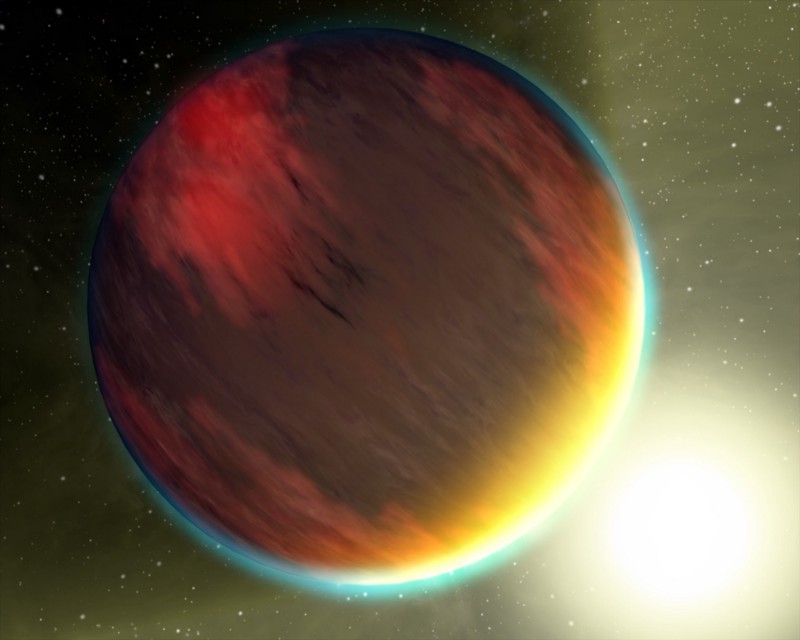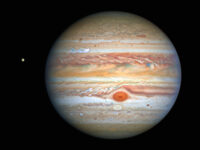Exoplanets are distant, mysterious cousins of our own home — obscure balls of rock and gas orbiting stars hundreds of light years away. It’s difficult to understand what might be on the surface: are they covered in global oceans? Made up of molten lava? Does it rain razor-sharp shards of glass at thousands of miles per hour? (All of these examples, by the way, are current hypotheses about actual exoplanets). Constructing a story of what an exoplanet might look like is a complex process, but it starts with one simple question: how hot is it?
Surface temperature is one of the most fundamental shaping factors of a planet, where even small shifts can result in dramatically different environments. To use Earth as an example, the difference between the coldest and hottest temperatures ever recorded (in Antarctica and California respectively) is only 265°F. By the standards of a human body this might seem like an enormous difference. But the universe works on very different temperature scales: between the cold of space at −454.81°F and the temperature of the hottest astronomical body in the neighborhood (the Sun, which is nearly 10,000°F at its surface), anything is fair game.
The universe works on very different temperature scales [from humans]: between the cold of space at −454.81°F and the temperature of the hottest astronomical body in the neighborhood (the Sun, which is nearly 10,000°F at its surface), anything is fair game.
The importance of heat comes down to phase changes. Materials have a characteristic threshold temperature at which they transition from one phase to another, like how liquid water will freeze into solid ice when cooled below 32˚F at sea level. The phases of materials on a planet’s surface can define what that environment looks like: an ice-covered world is fundamentally different from a hot, gassy one; a planet hot enough to have molten rock is very different from a temperate ocean world.
Precisely mapping exoplanet surface temperatures is near impossible even with the fantastic resolution of current telescopes, but estimates can be calculated from the characteristics of the planetary system. The first temperature assessment is derived from the heat of the star. A star produces heat through fusion reactions at its core, where light elements such as hydrogen or helium are fused into new, heavier elements, releasing explosions of excess energy. The more actively a star is fusing elements, the more energy is produced and the hotter it burns.
Estimates [of exoplanet surface temperatures] can be calculated from the characteristics of the planetary system.
This heat actually changes the way stars look, allowing astronomers to estimate temperature simply using color: cooler, smaller stars appear red, even to the naked eye, and hot massive stars appear blue. Just by looking at a star, we can estimate the amount of heat that any orbiting planets might be exposed to.
The amount of heat that is actually delivered to the planet’s surface is determined by its orbit. Generally, a close-in orbit will create a warm world, whereas a wide orbit creates a cooler one. But in some special cases, planets experience both extremes. Most observed planets have an elliptical orbit, spending only a brief moment close to its star before being slingshot farther into space. Changes in stellar irradiation over the course of its orbit can cause drastic shifts in temperature, subjecting the planet to fiery heat at closest approach and freezing cold at greater distances. These huge swings in temperature can drastically disrupt any weather or climate equilibrium on the surface, wreaking havoc on any potential habitability.
Things get really interesting when a planet has an atmosphere.
Things get really interesting when a planet has an atmosphere, which will accumulate if the planet is massive enough to gravitationally attract enough gas in its neighborhood (and far enough that it’s not burned off by its star). This envelope of gas acts like an insulating blanket, trapping heat from the star and distributing warmth around the entire planet. Without this distributive effect, heat would be concentrated on the star-facing side of the planet, resulting in a crispy dayside and a freezing night side. Movement of particles within the atmosphere triggered by this distribution of heat creates a dynamic global climate — and this dynamic nature is what makes surface temperature so difficult to precisely characterize.
When we dream of these distant worlds, we envision the shape of mountains, the vast expanses of oceans, perhaps even ecosystems of alien life. Characterizing exoplanet surfaces is a feat of technology still just out of reach — precise observations and sophisticated software models are enough to build amazing hypotheses, but don’t yet give definitive answers. As our telescopes and our knowledge of planetary systems grow, we may soon be able to peer onto these planets’ surfaces, and see worlds more amazing than we can imagine.
ISBN 978–0–8165–2945–2
DOI: arXiv:1009.1738v2
DOI: 10.3847/2041–8213/ab44ce






